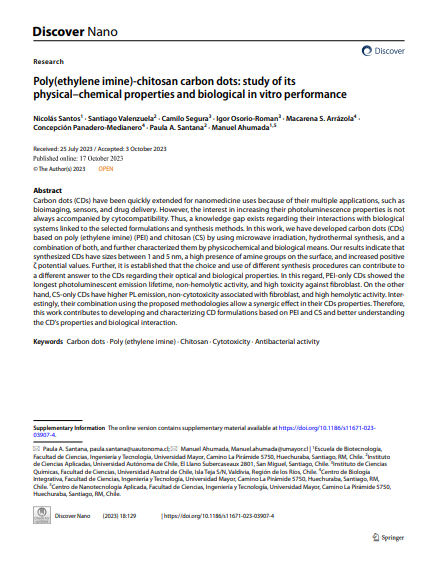Poly(ethylene imine)-chitosan carbon dots: study of its physical-chemical properties and biological in vitro performance

Fecha
2023-10-17Autor
Santos, Nicolás [Escuela de Biotecnología, Facultad de Ciencias, Ingeniería y Tecnología, Universidad Mayor, Chile]
Valenzuela, Santiago
Segura, Camilo
Osorio-Román, Igor
Arrázola, Macarena S. [Centro de Biología Integrativa, Facultad de Ciencias, Ingeniería y Tecnología, Universidad Mayor, Chile]
Panadero-Medianero, Concepción [Centro de Biología Integrativa, Facultad de Ciencias, Ingeniería y Tecnología, Universidad Mayor, Chile]
Santana, Paula A.
Ahumada, Manuel [Escuela de Biotecnología, Facultad de Ciencias, Ingeniería y Tecnología, Universidad Mayor, Chile]
Ubicación geográfica
Notas
HERRAMIENTAS
Acceda a títulos restringidos
¿Cómo descargar?Resumen
Carbon dots (CDs) have been quickly extended for nanomedicine uses because of their multiple applications, such as bioimaging, sensors, and drug delivery. However, the interest in increasing their photoluminescence properties is not always accompanied by cytocompatibility. Thus, a knowledge gap exists regarding their interactions with biological systems linked to the selected formulations and synthesis methods. In this work, we have developed carbon dots (CDs) based on poly (ethylene imine) (PEI) and chitosan (CS) by using microwave irradiation, hydrothermal synthesis, and a combination of both, and further characterized them by physicochemical and biological means. Our results indicate that synthesized CDs have sizes between 1 and 5 nm, a high presence of amine groups on the surface, and increased positive ζ potential values. Further, it is established that the choice and use of different synthesis procedures can contribute to a different answer to the CDs regarding their optical and biological properties. In this regard, PEI-only CDs showed the longest photoluminescent emission lifetime, non-hemolytic activity, and high toxicity against fibroblast. On the other hand, CS-only CDs have higher PL emission, non-cytotoxicity associated with fibroblast, and high hemolytic activity. Interestingly, their combination using the proposed methodologies allow a synergic effect in their CDs properties. Therefore, this work contributes to developing and characterizing CD formulations based on PEI and CS and better understanding the CD's properties and biological interaction.
URI
https://repositorio.umayor.cl/xmlui/handle/sibum/9454https://doi.org/10.1186/s11671-023-03907-4
https://cnap.umayor.cl/publicaciones/poly-ethylene-imine-chitosan-carbon-dots-study-of-its-physical-chemical-properties-and-biological-in-vitro-performance
https://europepmc.org/backend/ptpmcrender.fcgi?accid=PMC10581970&blobtype=pdf
https://www.ncbi.nlm.nih.gov/pmc/articles/PMC10581970/pdf/11671_2023_Article_3907.pdf
https://link.springer.com/article/10.1186/s11671-023-03907-4
Coleccion/es a la/s que pertenece:
Si usted es autor(a) de este documento y NO desea que su publicación tenga acceso público en este repositorio, por favor complete el formulario aquí.